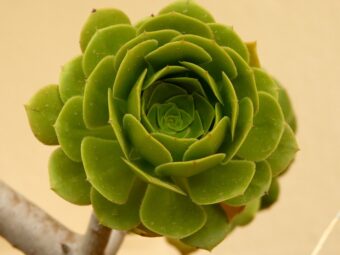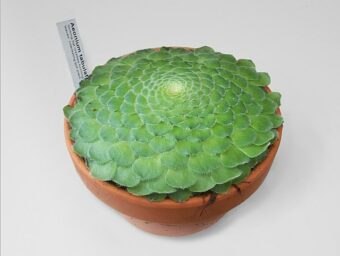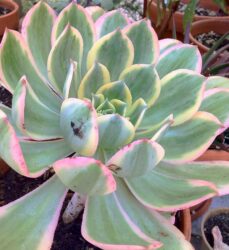In this article, we will discuss how to grow Aeoniums in containers to give a colourful summer display. They are often grown indoors in regions that have temperate climates.
It is a fleshy, succulent subshrub that originates from Madeira, Canary Islands and North Africa. They are members of the Crassula family, where they have a rosette of glossy, waxy leaves that can be colourful. The plants can be short growing up to a few centimetres tall to 1m high, where they can offer architectural grace and exotic beauty to any container display.

The leaves are wonderful but the flowers that paper in early to late spring is elegant, where clusters of tiny, mustard yellow blooms appear. The flowers are great but this is not the reason why the plant is grown, as often the leaves will steal the show. As said earlier they are often green but the leaves can be a dark, almost black colour or in some varieties it can be variegated, introducing yellow, red or white to the leaves.
IT IS NOT A PERMANENT DISPLAY BUT A TEMPORARY DISPLAY
Aeoniums are great as a temporary, summer display as it requires little maintenance and care. You can see it as a dual-purpose plant as a houseplant in winter, spring and autumn but as an outdoor container display in summer.

For a plant, it has an unusual growth pattern, where it grows actively in spring and autumn, where the light and temperature meets the plants’ growing needs. In hot summer the plant stops growing and the rosette often goes lighter in colour. Occasionally, you will see leaves dropping off after drying. Take this as perfectly normal. This means that you do not need to water in summer as they will live on the nutrients and water stored in the leaves.
The sad news is that Aeoniums die after flowering on varieties that bloom. Every rosette that flowers will die. These can be removed allowing the rest of the plant to live on. At this time, it is an ideal time to propagate the plant via cuttings.
WHERE TO GROW AEONIUMS
Aeoniums are sun worshippers, so choose a spot that gets plenty of sunlight. In spring and autumn, water the plant thoroughly but allow the compost to dry out between waterings, which mimics the raindrops that fall on the plant.
The plant is a succulent and can go through periods without water.
In summer and winter, water sparingly and only when the compost gets dry throughout, once nighttime temperatures start to get below 10 degrees Celsius, it is time to bring the plants in and get them used to the home environment. This means that in summer the plant will need protection from rain, so you may need to grow it under the protection of a rain shadow (where little rain falls).
Outside it is best to grow them in containers as you can provide the ideal growing media, as the roots will rot if it is too wet. Good drainage is the key. It is best to grow Aeoniums in terracotta containers as this will help with drainage as long as they have drainage holes at the bottom.
HOW TO PLANT AN AEONIUM
Use a 15cm in diameter terracotta pot as it is porous and allows the soil to dry out between waterings. To the container, add a 3cm layer of gravel to help with the drainage even more.
Fill the container with a 60% by volume of multipurpose compost with 40% horticultural grit by volume to make a free-draining growing media. Dig a hole that is slightly bigger than the original root ball. Place the plant in at the level it came in the original container and backfill with the growing media. Add more to fill any gaps that remain. Firm the plant in and water lightly to allow it to settle. On top of the compost, it is advised to add a 1cm layer of horticultural grit to help with drainage and to reduce the amount of water that is lost due to evaporation.
If you are growing a flat top Aeonium tabuliforme, tilt the pot at an angle so that any water will drain away from the plant very easily.
LOOKING AFTER AEONIUMS
In the natural environment, Aeoniums live in hot, arid areas that get an occasional downpour. You will need to replicate this if you want the plants to succeed. Allow the soil to dry out between waterings, making sure the excess water drain away. In hot summers, you will need to offer protection to avoid root rot caused by overwatering.
Once a month feed your Aeonium with a liquid fertilizer at half its recommended strength from winter to spring, As said early, bring it back to the home when the nighttime temperature starts to hit below 10 degrees Celsius.
PESTS AND DISEASES WITH AEONIUMS
Do not overwater your plant as it will lead to root rot and the death of your plant. It will also lead to your plant looking pale. You must control the amount of moisture the plant is exposed to.

If your plant becomes leggy then this is a sign that the plant is not getting enough water. Aeoniums naturally produce hairy stems, which are aerial roots and are nothing to worry about. However, it may indicate that the plant is either getting too much water, not enough water or too little light. If you do what is suggested in the article you cannot go wrong.
You may get mealybugs on the leaves, which can be treated with a suitable insecticide. Vine weevils are another potential problem, where the first indicator is the plant is dying because the roots have been eaten. The young larvae eat the roots, whilst the adult beetles eat the leaves. Treat these with suitable systemic insecticides or better suitable nematodes.
VARIETIES TO GROW
Aeonium ‘Zwartkop’ is a branching Aeonium that has dark, almost black leaf rosettes that are green at the centre. Perfect in a container in a container display where it will grow up to 1m high.
Aeonium tabuliforme is a flat-topped Aeonium that is known for its wide, flat diameter plate-like rosettes. It can grow up to 10cm high.
Aeonium ‘Sunburst’ has large, pale yellow, large rosette with white and green stripes with pink margins. Will grow up to 70cm high.
Aeonium ‘Blushing Beauty’ is an attractive Aeonium with green leaves that are red blushed. It can grow up to 1m high.
CONCLUSIONS
In this article, we have discussed how to grow this attractive succulent subshrub in containers. We have discussed how to plant them, how to care for them, what varieties to grow and potential pitfalls that they may suffer from.
They are easy to look after, requiring little in the way of care. You can bring them out in summer, but other times it is a houseplant.
You have many choices but I hope you buy one soon.
If you have any questions or comments on growing Aeonium in containers, please do so in the comment box below.
Happy Aeonium growing.
